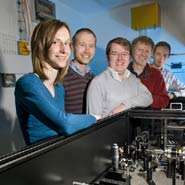Solving the solvent mystery for better drug design

Scientists from the University of Bristol have been able to watch a chemical reaction happening in solution with more detail than ever before. This could lead to improved drug design for medical therapies and catalysts for industrial processing, and pave the way for further applications in bio- and atmospheric chemistry.
The results are published in Science Express online.
The ULTRA experiments, which took place at the Science and Technology Facilities Council’s Lasers for Science Facility (LSF) at the Rutherford Appleton Laboratory in Oxfordshire, will provide scientists with a unique insight into how liquid solvents affect chemical reactions at the molecular level.
This can be in solution in liquids such as organic solvents or water. Organic solvents are used in the chemical and pharmaceutical industries for a wide range of industrial processes such as the manufacture of drug molecules for medical therapies. Similarly, much of the chemistry in the cells of living organisms takes place in solution so understanding these chemical reactions on such a fundamental level is vital.
Heading up the programme is Professor Andrew Orr-Ewing from the School of Chemistry who said; “We are very excited by the results - especially as 2011 is International Year of Chemistry. Liquids have a disordered and rapidly changing structure, and collisions between molecules occur on timescales as fast as ten thousand billion collisions per second. It is now possible for us to examine chemical reactions within a solvent at unprecedented levels of detail on picosecond timescales (one thousand-billionths of a second). We wouldn’t have been able to do this without the unique capability of the ULTRA laser.”
The knowledge gathered during these experiments will be used to better inform computer models designed to simulate chemical reactions in liquids.
Provided by University of Bristol
















